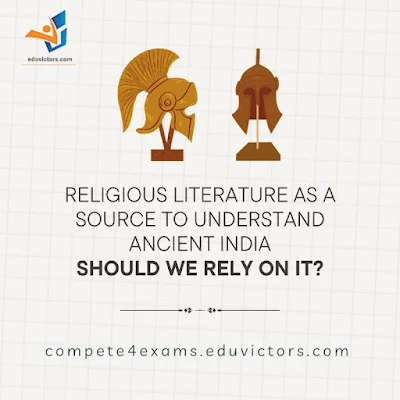Religious Literature as a Source to Understand Ancient India: Should we rely on it? #HistoryNotes #eduvictors #compete4exams
Religious Literature as a Source to Understand Ancient India: Should we rely on it?
Introduction
India has a rich cultural heritage and some historians believe that India's history is more than 5,000 years old. Finding reliable sources to interpret historical facts correctly is a daunting task for historians. We must go back to Ancient India to comprehend present-day India. Ancient India's rich and diverse history is illuminated through a vast array of literary sources, and among the most significant are religious texts. The religious literature, though primarily religious, throws light on the socio-economic, political and even ideological aspects of the period. But religious sources need to be used with huge caution.
Religious Literary Sources of Ancient India
Vedas: The oldest sacred texts of Hinduism, comprising the Rigveda, Yajurveda, Samaveda, and Atharvaveda, offer hymns, rituals, and philosophical discussions.
Upanishads: These texts delve into the metaphysical and philosophical aspects of life, delving into concepts like Atman (soul) and Brahman (ultimate reality).
Bhagavad Gita: A part of the Indian epic Mahabharata, this text discusses moral dilemmas, duty (dharma), and the paths to spiritual realization.
Puranas: These are the ancient Indian texts like the Vishnu Purana, Shiva Purana, and Bhagavata Purana that have mythological stories, talk about other cosmological worlds and describe rituals to worship gods and goddesses.
Dharma Shastras: These include texts like Manusmriti, Aranyakas, Brahmanas, and Upanishads that provide insights into the legal and social norms of ancient Indian society.
Buddhist Literature: Tripitakas (Sutta, Vinaya and Abhidhammapitaka), Jataka stories, Dipvamsha, Mahavamsa
Jaina Literature: Anga, Agamas, Chedasutras, Mulsutras etc.
Advantages of Using Religious Literature as a Source
- Religious texts are valuable sources of information about ancient India because these texts provide information about the culture, history, philosophy, and traditions of that era. Cultural insights: Religious texts can tell us about the cultural practices, rituals, and beliefs of ancient India.
- Historical context: Religious texts can also provide historical narratives and references.
- Philosophical depth: Religious literature can explore profound philosophical concepts. It gives us an idea of the intellectual level and philosophical knowledge they used to have.
- Continuity of traditions: Many rituals and traditions described in religious texts have persisted through the centuries. This tries to establish the link between ancient and contemporary India.
It is important to note that religious literature is not always a reliable source of information. It is important to critically evaluate the text and to consider the biases of the author. However, when used carefully, religious literature can be a valuable tool for understanding the past.
Disadvantages of Using Religious Literature as a Source
- Religious Bias: Religious texts may be written with a particular theological agenda, which can introduce bias and subjectivity into historical accounts.
- Selective Narratives: These texts often focus on specific events and figures, potentially leaving out essential aspects of society and history.
- Interpretational Challenges: Ancient texts may be written in languages that are no longer in common use, interpreting a complex task.
- Historicity: Not all events described in religious literature can be verified as historical facts, raising questions about their accuracy.
Precautions for Using Religious Literature as a Source
- Cross-Referencing: Always cross-reference information from religious texts with other historical sources to ensure accuracy and objectivity.
- Understanding Theological Bias: Be aware of the religious bias that may be present in these texts and consider it when analysing their content.
- Language Proficiency: Seek the assistance of experts or scholars who are proficient in the language and culture of the era to aid in interpretation.
- Contextual Analysis: Analyze the texts within their historical, cultural, and social contexts to better understand their significance and limitations.
The majority of religious sources were passed down from one generation to the next through oral traditions. Additionally, religious literature was mainly written to guide society with an idealist approach.
Conclusion
Religious literature serves as a valuable source for understanding ancient India, offering profound insights into its culture, philosophy, and traditions. However, it is essential to approach these texts with caution, considering the potential biases and limitations they may possess. By employing critical analysis and cross-referencing with other historical sources, researchers can unlock the treasures of knowledge hidden within India's religious texts, providing a more comprehensive understanding of its ancient past.
SEE ALSO:





No comments